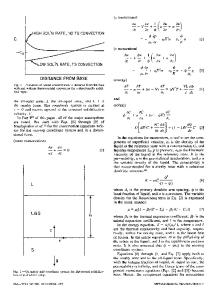Effects of forced electromagnetic vibrations during the solidification of aluminum alloys: Part II. solidification in th
- PDF / 976,832 Bytes
- 8 Pages / 612 x 792 pts (letter) Page_size
- 86 Downloads / 338 Views
I.
II.
INTRODUCTION
IT is an established fact that in industrial production of ferrous and nonferrous alloys, which is obviously of great commercial importance, equiaxed dendritic, or nondendritic, solidification is much more desirable, from many standpoints, than columnar solidification. Indeed, fine-grained structures have improved low temperature strength and toughness, reduced anisotropy, reduced microsegregation, better heat treatment, and reduced hot tearing tendency. Furthermore, grain refining offers substantial improvements in continuous casting processes by increasing the casting speed, reducing cracking and cold shots, and improving surface quality of the ingots. [~-~u The fundamental investigation presented in Part IV21has shown that the grain refinement can be effective, when an alloy is electromagnetically vibrated under favorable conditions, concerning primarily the amplitude of the oscillating pressure. Several attemptsIU] to irradiate continuously cast aluminum alloy ingots by mechanoacoustic methods were performed on the industrial scale (Figure 1). However, the mechanical vibrations approach is characterized by several specific and serious drawbacks, already pointed out in Part I.~21 Consequently, the use of such a process is currently very restricted and is reserved for the irradiation of very small ingots. Part II reports on the examination of the possible industrial application of a noncontact electromagnetic method of production of vibrations in aluminum alloy melts for both the continuous casting of billets and slabs and the casting in permanent molds. Moreover, a comparative study of the interaction between the electromagnetic, hydrodynamic, thermal, and crystal growth phenomena, which occur in typical examples of crystallization of aluminum alloys in the presence either of natural, forced and damped convection, or electromagnetic vibrations, has also been performed.
The principle consists of the simultaneous application of a stationary magnetic field B o and of a variable magnetic field b in the vicinity of the molten metal during the course of solidification (Figure 2); these magnetic fields are nearly parallel to the vertical axis of the ingot. The stationary magnetic field is generated by at least one coil, which is supplied with direct current. The alternating magnetic field is created by another inductor, which is of similar geometry, supplied with an alternating current of frequency N. Under the effect of the periodic current, the inductor generates a variable field b in the melt which, in turn, gives rise to an induced periodic current of density j (Figure 2). The combined action of the colinear fields generates vibrations in the metal pool, which are of a double origin. The interaction of Bo and j engenders a vibrating force of frequency N, whereas the j x b force consists of a time-independent component and an oscillatory component of frequency 2N. The electromagnetic vibrations mainly originate inside the electromagnetic skin depth area and, owing to the medium elasticity, ar
Data Loading...










